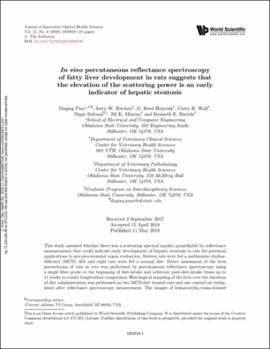| dc.contributor.author | Piao, Daqing | |
| dc.contributor.author | Ritchey, Jerry W. | |
| dc.contributor.author | Reed Holyoak, G | |
| dc.contributor.author | Wall, Corey R. | |
| dc.contributor.author | Sultana, Nigar | |
| dc.contributor.author | Murray, Jill K. | |
| dc.contributor.author | Bartels, Kenneth E. | |
| dc.date.accessioned | 2023-07-06T19:25:41Z | |
| dc.date.available | 2023-07-06T19:25:41Z | |
| dc.date.issued | 2018-05-11 | |
| dc.identifier | oksd_piao_in_vivo_precutaneous_reflectance_2018 | |
| dc.identifier.citation | Piao, D., Ritchey, J.W., Reed Holyoak, G., Wall, C.R., Sultana, N., Murray, J.K., Bartels, K.E. (2018). In vivo percutaneous reflectance spectroscopy of fatty liver development in rats suggests that the elevation of the scattering power is an early indicator of hepatic steatosis. Journal of Innovative Optical Health Sciences, 11(4), 1850019. https://doi.org/10.1142/S1793545818500190 | |
| dc.identifier.issn | 1793-5458 | |
| dc.identifier.uri | https://hdl.handle.net/11244/337897 | |
| dc.description.abstract | This study assessed whether there was a scattering spectral marker quantifiable by reflectance measurements that could indicate early development of hepatic steatosis in rats for potential applications to pre-procurement organ evaluation. Sixteen rats were fed a methionine-choline-deficient (MCD) diet and eight rats were fed a normal diet. Direct assessment of the liver parenchyma of rats in vivo was performed by percutaneous reflectance spectroscopy using a single fiber probe at the beginning of diet-intake and arbitrary post-diet-intake times up to 11 weeks to render longitudinal comparison. Histological sampling of the liver over the duration of diet administration was performed on two MCD-diet treated rats and one control rat euthanized after reflectance spectroscopy measurement. The images of hematoxylin/eosin-stained liver specimens were analyzed morphometrically to evaluate the lipid size changes associated with the level of steatosis. The MCD-diet-treated group (n=16) had mild steatosis in seven rats, moderate in three rats, severe in six rats, and no other significant pathology. No control rats (n=8) developed hepatic steatosis. Among the parameters retrieved from per-SfS, only the scattering power (can be either positive or negative) appeared to be statistically different between MCD-treated and control livers. The scattering power for the 16 MCD-diet-treated livers at the time of euthanasia and presenting various levels of steatosis was 0.33±0.21, in comparison to 0.036±0.25 of the eight control livers (p=0.0189). When evaluated at days 12 and 13 combined, the scattering power of the 16 MCD-diet-treated livers was 0.32±0.17, in comparison to 0.10±0.11 of the eight control livers (p=0.0017). All of four MCD-treated livers harvested at days 12 and 13 presented mild steatosis with sub-micron size lipid droplets, even though none of the MCD-treated livers were sonographically remarkable for fatty changes. The elevation of the scattering power may be a valuable marker indicating early hepatic steatosis before the steatosis is sonographically detectable. | |
| dc.format | application/pdf | |
| dc.language | en_US | |
| dc.publisher | World Scientific Publishing | |
| dc.relation.ispartof | Journal of Innovative Optical Health Sciences, 11 (4) | |
| dc.rights | This material has been previously published. In the Oklahoma State University Library's institutional repository this version is made available through the open access principles and the terms of agreement/consent between the author(s) and the publisher. The permission policy on the use, reproduction or distribution of the material falls under fair use for educational, scholarship, and research purposes. Contact Digital Resources and Discovery Services at lib-dls@okstate.edu or 405-744-9161 for further information. | |
| dc.title | In vivo percutaneous reflectance spectroscopy of fatty liver development in rats suggests that the elevation of the scattering power is an early indicator of hepatic steatosis | |
| dc.date.updated | 2023-07-02T13:29:11Z | |
| dc.note | open access status: Gold OA | |
| dc.identifier.doi | 10.1142/S1793545818500190 | |
| dc.description.department | Electrical and Computer Engineering | |
| dc.description.department | Veterinary Clinical Sciences | |
| dc.type.genre | Article | |
| dc.type.material | Text | |
| dc.subject.keywords | atomic, molecular and optical physics | |
| dc.subject.keywords | physical sciences | |
| dc.subject.keywords | liver disease | |
| dc.subject.keywords | chronic liver disease and cirrhosis | |
| dc.subject.keywords | nutrition | |
| dc.subject.keywords | bioengineering | |
| dc.subject.keywords | digestive diseases | |
| dc.subject.keywords | optical physics | |
| dc.identifier.author | ORCID: 0000-0003-0922-6885 (Piao, D) | |
| dc.identifier.author | ScopusID: 7005153312 | 57220465193 (Piao, D) | |
| dc.identifier.author | ResearcherID: I-1341-2013 (Piao, D) | |
| dc.identifier.author | ORCID: 0000-0003-0307-4673 (Ritchey, JW) | |
| dc.identifier.author | ScopusID: 7006378376 (Ritchey, JW) | |
| dc.identifier.author | ScopusID: 6701722645 (Reed Holyoak, G) | |
| dc.identifier.author | ScopusID: 57207754921 (Wall, CR) | |
| dc.identifier.author | ScopusID: 57197676969 (Sultana, N) | |
| dc.identifier.author | ScopusID: 56677134900 (Murray, JK) | |
| dc.identifier.author | ScopusID: 7005400149 (Bartels, KE) | |
| dc.identifier.essn | 1793-7205 | |
